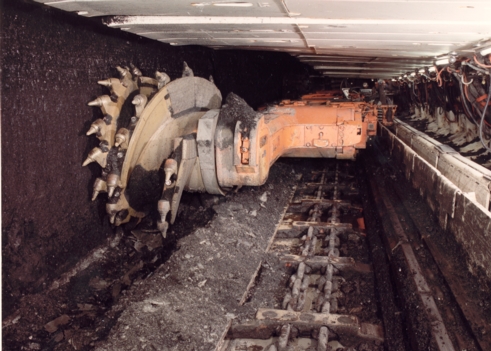
Longwall Mining

Longwall mining has had the biggest impact
on U.S. underground coal operations over the past 20 years. Although the concept
originated in Europe, modern longwall mining in the U.S. began in 1960 and as
equipment improved, became more widely used in the 70's. Since then, longwall
mining has experienced substantial growth, increasing from less than 10% of
total underground production to the current level of 50%.
Longwall mining is a highly productive underground mining method in which
a panel or block of coal sometimes 1,000 feet wide and two or three miles long
is completely extracted. The working area is protected by movable hydraulic
powered roof supports called shields. The longwall employs a shearer, with two
rotating cutting drums, which is dragged mechanically back and forth across the
coal face. The coal which is cut falls onto a heavy chain conveyor which
delivers it to a belt conveyor system for removal out of the mine. The longwall
shields advance with the machine as mining proceeds and provide not only high
levels of production but also increased miner safety.
Some longwall mining systems employ sensors to detect how much coal
remains in the seam being mined as well as robotic controls to enhance
efficiency. Microprocessors record seam data as a longwall miner makes it
initial pass, subsequent passes then follow the previous route resulting in high
efficiencies.
With the use of a longwall system, the amount of coal which is recovered in a given area increases from 50% to as much as 80% where geology is favorable. The carefully planned longwall process has a positive influence on minimizing the effects of subsidence. Gradual or occasionally abrupt collapse of rock layers sometimes occurs between an underground mine and the surface. With the longwall operation such ground movements are completed in a shorter period of time and the settling process occurs in a more uniform and predictable manner helping to minimize surface impacts. For these and other reasons, longwall production has increased substantially and today accounts for the largest amount of tonnage among underground mining methods.